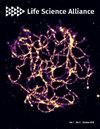VCP/p97 介导非 ER 导入的朊病毒蛋白的核靶向,以维持蛋白稳态。
IF 3.3
2区 生物学
Q1 BIOLOGY
引用次数: 0
摘要
分泌蛋白在细胞质中的错误靶向会引发它们的聚集和随后的蛋白稳态下降。我们发现了一种依赖 VCP/p97 的途径,它能引导非 ER 导入的朊病毒蛋白(PrP)进入细胞核,以防止在细胞质中形成有毒的聚集体。PrP转位到ER受损后,会与VCP/p97相互作用,从而促进由importin-ß介导的核导入。值得注意的是,PrP 与 VCP/p97 的胞浆相互作用及其核导入与泛素化无关。体外实验显示,VCP/p97 可结合未泛素化的 PrP 并阻止其聚集。抑制PrP与VCP/p97的结合,或瞬时蛋白毒性应激,会促进细胞质中形成自我延续的、部分具有蛋白酶抗性的PrP聚集体,从而破坏细胞蛋白稳态,干扰PrP进一步的核靶向。在细胞核中,RNA 使 PrP 保持可溶和无毒的构象。我们的研究揭示了 VCP/p97 在非导入分泌蛋白的核靶向中发挥的不依赖泛素的新作用,并强调了化学环境在引发蛋白质错误折叠方面的影响。本文章由计算机程序翻译,如有差异,请以英文原文为准。
VCP/p97 mediates nuclear targeting of non-ER-imported prion protein to maintain proteostasis.
Mistargeting of secretory proteins in the cytosol can trigger their aggregation and subsequent proteostasis decline. We have identified a VCP/p97-dependent pathway that directs non-ER-imported prion protein (PrP) into the nucleus to prevent the formation of toxic aggregates in the cytosol. Upon impaired translocation into the ER, PrP interacts with VCP/p97, which facilitates nuclear import mediated by importin-ß. Notably, the cytosolic interaction of PrP with VCP/p97 and its nuclear import are independent of ubiquitination. In vitro experiments revealed that VCP/p97 binds non-ubiquitinated PrP and prevents its aggregation. Inhibiting binding of PrP to VCP/p97, or transient proteotoxic stress, promotes the formation of self-perpetuating and partially proteinase resistant PrP aggregates in the cytosol, which compromised cellular proteostasis and disrupted further nuclear targeting of PrP. In the nucleus, RNAs keep PrP in a soluble and non-toxic conformation. Our study revealed a novel ubiquitin-independent role of VCP/p97 in the nuclear targeting of non-imported secretory proteins and highlights the impact of the chemical milieu in triggering protein misfolding.
求助全文
通过发布文献求助,成功后即可免费获取论文全文。
去求助
来源期刊

Life Science Alliance
Agricultural and Biological Sciences-Plant Science
CiteScore
5.80
自引率
2.30%
发文量
241
审稿时长
10 weeks
期刊介绍:
Life Science Alliance is a global, open-access, editorially independent, and peer-reviewed journal launched by an alliance of EMBO Press, Rockefeller University Press, and Cold Spring Harbor Laboratory Press. Life Science Alliance is committed to rapid, fair, and transparent publication of valuable research from across all areas in the life sciences.
 求助内容:
求助内容: 应助结果提醒方式:
应助结果提醒方式:


